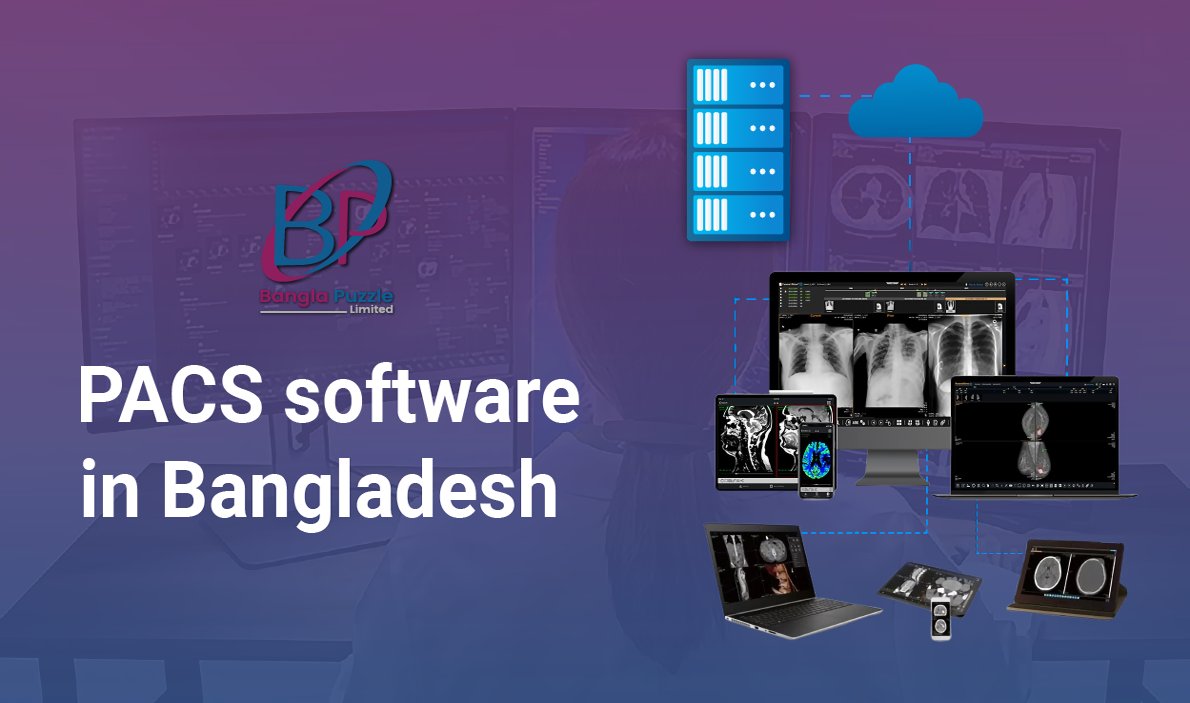
PACS software in Bangladesh
PACS (Picture Archiving and Communication System) software is a medical imaging technology. This software is used in healthcare facilities, primarily radiology departments, to store, retrieve, manage, distribute, and present medical images electronically. It replaces the traditional methods of storing and managing medical images on film.
Key Functions of PACS Software:
Now I am sharing some key functions of PACS Software.
1. Image Storage and Retrieval: PACS provides for the digital storage of medical images such as X-rays, MRIs, CT scans, and ultrasounds. These images can be retrieved quickly for review by healthcare providers like doctors, reviewers etc.
2. Image Distribution: PACS provides the distribution of images across different departments or healthcare facilities. Doctors can access the images from various locations, which is especially useful for remote consultations and multi-disciplinary teams.
3. Image Presentation: PACS software facilitates tools for viewing and analyzing images. This includes functions like zooming, rotating, and adjusting contrast or brightness. Advanced PACS systems may also support 3D visualization. Our PACS system gives this 3D visualization facilities.
4. Integration with Other Systems: PACS often integrates with other healthcare information systems such as the Radiology Information System (RIS) and Electronic Health Records (EHR). This integration facilitates a more streamlined workflow, allowing for better patient care.
5. Archiving: PACS systems have long-term storage capabilities, ensuring that images are stored securely and can be accessed even years after they were taken.
Benefits of PACS
Now I am sharing the benefits of our PACS software.
Efficiency: PACS software increases efficiency in diagnosis and treatment. Eliminates the need for physical film and manual retrieval, reducing delays in diagnosis and treatment.
Cost Savings: PACS system reduces costs associated with film, storage, and transportation of physical images.
Accessibility: This system enables remote access to images, which is crucial for telemedicine and consultations between specialists.
Improved Patient Care: This system provides faster access to imaging results, leading to quicker diagnosis and treatment planning.
PACS is a critical component of modern medical imaging departments, enhancing the way images are managed and utilized in healthcare settings.
The price of PACS software can vary widely depending on several factors, including the size of the healthcare facility, the features and functionalities required, the vendor, and whether the software is purchased outright or accessed via a subscription model. Here's a general overview:
1. Small to Medium-Sized Facilities:
Cost: $2,000 to $5,000
Details: Smaller clinics or radiology practices may opt for basic PACS solutions with essential features. These systems are more affordable but may have limitations in terms of scalability and advanced functionalities.
2. Large Hospitals or Multi-Facility Networks:
Cost: 5,000 to 20,000 or more
Details: Larger healthcare organizations typically require more robust and scalable PACS solutions. These systems offer advanced features like 3D imaging, integration with multiple systems (e.g., RIS, EHR), and support for a higher volume of users and data storage.
3. Cloud-Based PACS Solutions:
Cost: $3,000 to $6,000 per year (subscription-based)
Details: Cloud-based PACS solutions are becoming increasingly popular due to their flexibility and lower upfront costs. These systems are typically offered as a subscription service with ongoing costs based on usage, storage needs, and the number of users.
4. Additional Costs:
Implementation and Training: $3,000 to $20,000, depending on the complexity.
Maintenance and Support: Typically 10-20% of the purchase price annually.
Hardware Costs: Additional costs for servers, workstations, and networking infrastructure if not included in the PACS package.
Customization and Licensing:
Customization: If the system needs to be customized to fit specific workflows or integrate with existing systems, costs can increase.
Licensing: Some vendors charge per user or per workstation, which can add to the overall cost.
Overall, the total cost of a PACS system can range from a few thousand dollars for basic, cloud-based solutions to several hundred thousand dollars for comprehensive, enterprise-level systems. It's essential for healthcare facilities to carefully assess their needs and budget before investing in a PACS solution.
PACS software in Bangladesh
Bangla Puzzle Limited provides PACS software to hospitals, diagnostics centers and 3rd party vendors.
You can contact us in physical address or Whatsapp:
Bangla Puzzle Limited
House: 13/3, Road: 2,
Shyamoli, Dhaka - 1207
+8801880811048
